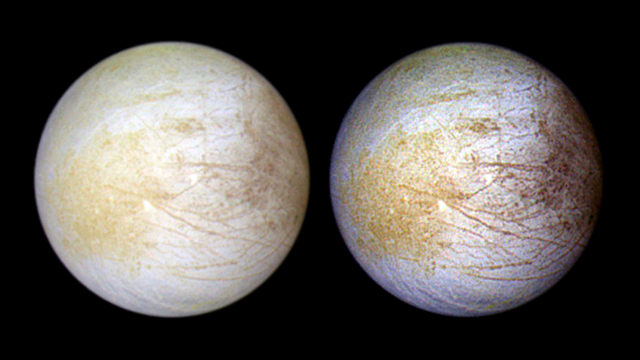
This color composite view combines violet, green, and infrared images of Jupiter’s intriguing moon, Europa, for a view of the moon in natural color (left) and in enhanced color designed to bring out subtle color differences in the surface (right). The bright white and bluish part of Europa’s surface is composed mostly of water ice, with very few non-ice materials. In contrast, the brownish mottled regions on the right side of the image may be covered by hydrated salts and an unknown red component. The yellowish mottled terrain on the left side of the image is caused by some other unknown component. Long, dark lines are fractures in the crust, some of which are more than 1,850 miles (3,000 kilometers) long.
North is to the top of the picture and the Sun fully illuminates the surface. Europa is about 1,950 miles (3,160 kilometers) in diameter, or about the size of Earth’s moon. The finest details that can be discerned are 15.5 miles (25 kilometers across). The images in this global view were taken in June 1997 at a range of 776,700 miles (1.25 million kilometers) by the Solid State Imaging (SSI) system on NASA’s Galileo spacecraft, during its ninth orbit of Jupiter.
The Jet Propulsion Laboratory (JPL) in Pasadena, California manages the Galileo mission for NASA’s Office of Space Science, Washington, DC. JPL is an operating division of California Institute of Technology (Caltech).
This image and other images and data received from Galileo are posted on the World Wide Web, on the Galileo mission home page at http://galileo.jpl.nasa.gov. Background information and educational context for the images can be found at http://www.jpl.nasa.gov/galileo/sepo.
Click here for original story, Europa Global Views in Natural and Enhanced Colors
Source: HubbleSite